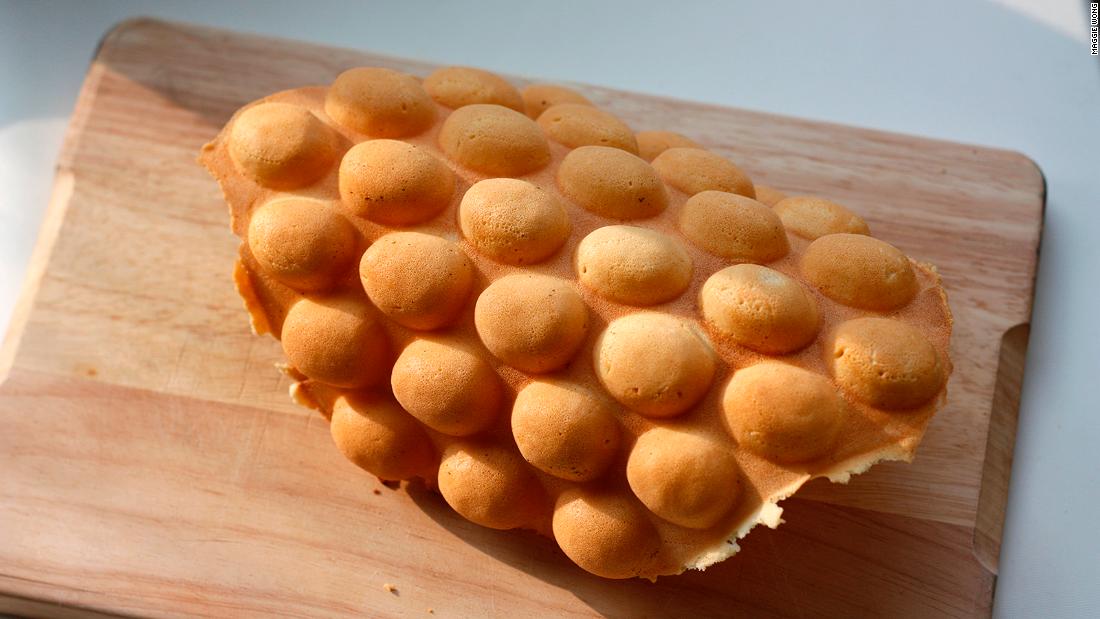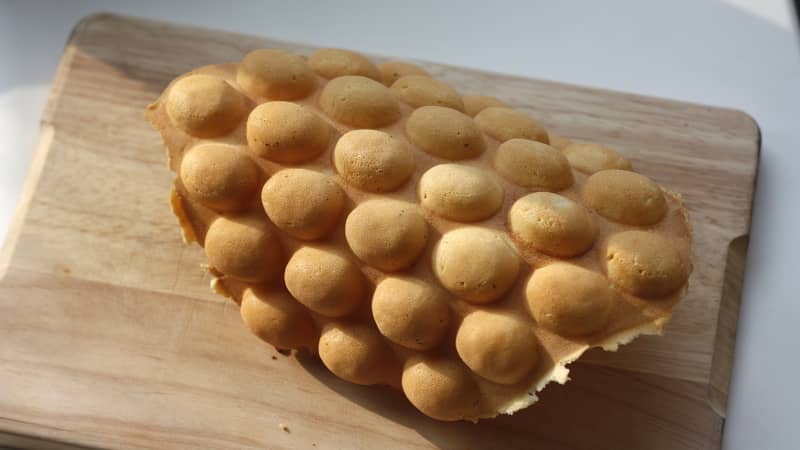I was wrong.
A seemingly unexceptional cheap street food found throughout the city, these snacks are crispy on the outside, while each “bubble” is fluffy on the inside. Called “gai daan jai” in Cantonese, their texture can be described as a cookie and sponge cake hybrid.
I kicked off my quest with a visit to Shanghai Street in Kowloon. Filled with kitchenware shops, it’s a popular destination for those buying bubble waffle irons.
“We all import our waffle irons from China these days,” said one shopkeeper. “Choy Tung Shing may be your best chance.”
It was a reasonable suggestion. Choy Tung Shing is one the oldest remaining blacksmiths in Hong Kong — most famous for its handmade ovens used for Cantonese roasted pork and goose.
But there, too, the owner struggled with my request.
“I’ve looked everywhere but couldn’t find anything about Hong Kong bubble waffle irons in my father’s old sketches and notes,” says Leung Wing Cheung, the third-generation owner of the century-old kitchenware store/factory.
“Are you sure you want to write about bubble waffles? Why not char siu (barbecue roasted pork) or something more remarkable?”
What’s so special about Hong Kong egg waffles?

The new, evolved gai daan jai. The waffle is curled into a cone and filled with ice cream or whipped cream.
Maggie Wong
I used to hold similar views, until 2016, when I quit my full-time job and moved to London where, one cold winter, I opened a street market stall selling Hong Kong bubble waffles under an undersized tarp that barely kept out the relentless rainwater.
It was a response to a bad gai daan jai experience a year earlier, when I tried a reinvented egg waffle in another London street food market.
The “new” bubble waffle was rolled up into a cone, which was stuffed with colorful ice cream and toppings. I took a bite and instantly felt cheated. It was a soft pancake disguised as a bubble waffle.
From that moment, I decided I’d introduce my own version of gai daan jai to London.
Back in Hong Kong, I took a crash course from a retired waffle street vendor. Nine months later, I opened for business in London.
The first customer came.
“Hong Kong bubble waffle?” the Korean traveler asked.
“Yes, like a bubble wrap,” I nodded.
My iron failed to heat up in the chilly London winter. The waffle wouldn’t come off the iron in one piece. It took me 30 minutes and many apologetic smiles until I was able to complete my first order.
The forgiving customer took a bite and was happy.
I was elated.
At the time, I thought the experience was purely personal, but I later came to realize that I was part of the global rise of our humble city waffle.
Bubble waffle shops have been popping up around Europe in the last few years, drawing crowds and getting plenty of Instagram likes.
They’ve traveled to the United States, too. In 2018, a bubble waffle shop was invited to set up shop at the Super Bowl.
Unlike many Cantonese dishes like char siu or dim sum, which with a few exceptions remain largely unevolved, Hong Kong egg waffles have transformed and are now gaining fans far beyond the streets of the world’s Chinatowns.
How was the first bubble waffle invented?
A few years after my one-year stint as a bubble waffle vendor, I was back in Hong Kong and ready to learn more about the history and stories of the Hong Kong snack to which we’ve grown so accustomed.
I was surprised by how the humble waffle has subtly weaved its way into becoming a strong part of our city’s history and culture since its invention in the 1950s.
“In the last decade, there has been a rise in the need to understand our local identity in Hong Kong,” says Siu Yan Ho, a lecturer in food literature and cultural studies at Hong Kong’s Lingnan University.
“More people talk about food, not merely as a food review, but about the relationship between the community and our food. Studying the history of food is closely related to the history of a city. Egg waffles embody the lifestyle of Hong Kong in the 1950s and exemplify the city’s transformation throughout the years.”
But still, I could find no concrete documentation about the backstory of egg waffles.
“One of the reasons is that it’s too common a food. One that doesn’t connote certain messages or status,” says Siu.
The most likely origin story, according to Siu’s research, is that the food was born out of necessity during trying times.
“Hong Kong bubble waffles were invented after the war, when the economy was bleak,” he says.
“Businesses would find ways to reinvent and utilize their meager supplies. It was likely that a grocery shop owner invented it to utilize unsold eggs. With flour and sugar — ingredients easily found in shops — egg waffles were born.”
And what about the shape? Siu has a theory for that, too.
“Its unique form was intended to make it look more nutritious,” he says. “Being economical and nutritious were two emphases in Hong Kong at that time.”
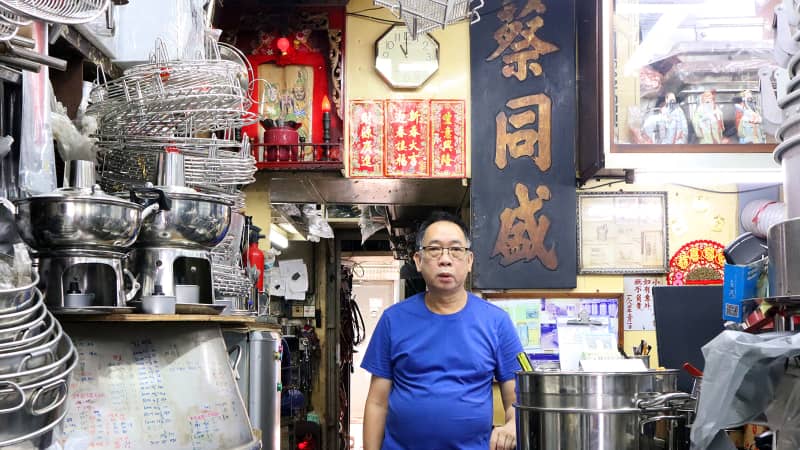
Leung Wing Cheung, the third-generation owner of the Choy Tung Shing kitchenware factory.
Maggie Wong
The waffle iron wasn’t molded to look like bubble wrap but, most likely, to mimic dozens of mini eggs. In those days, a bubble waffle was broken into 30 separate pieces, with each bubble sold on its own, instead of one big waffle as it’s served now.
“People couldn’t afford an entire egg waffle,” says waffle iron maker Leung, who was born in the 1950s.
“In the ’70s, there were more street hawkers and demands for bubble waffle irons increased. The hawkers usually bought a few irons at once as the irons got confiscated all the time.”
Street hawkers and the economy
It’s said that the rise and fall of Hong Kong’s hawkers reflects the state of the city’s economy.
In the 1960s and 1970s, the city was experiencing another economic crisis, alongside an influx of new immigrants from mainland China. Many unemployed people turned to hawking to make a living.
These include Lee Sui Yuen, who just happens to be my bubble waffle teacher.
Lee came to Hong Kong in the 1970s from mainland China and soon turned to bubble waffles.
“The competition was fierce but my gai daan jai were so good even I liked eating them,” he says.
“In the last few years before I retired, I only opened for business occasionally. Word would spread quickly and people would drive to buy gai daan jai from me.”
He made his bubble waffles the traditional way — grilled over a charcoal fire instead of with an electronic pan, which is what most shops do nowadays.
But, it was a hard way to earn a living given the legalities of selling on the street. To improve hygiene and tidiness, the government stopped issuing new hawker licenses in the 1970s, making new vendors illegal. The city began phasing out old licenses more vigorously in the 1990s.
“Being a street hawker had taken a toll on my heart. I was fearful of being caught by the hawker control team all the time,” he says as he shows me the scar where a pacemaker was placed inside his chest.
Now retired, Lee’s face lights up when talking about bubble waffles. He can still list all of the ingredients and processes without hesitating.
“To make a good waffle, you need to have good ingredients, good technique, as well as good weather. Gai daan jai made in the winter in Hong Kong are especially crispy and delicious because of the low humidity,” he says.
“But if you don’t heat up the iron well enough in winter, your waffle will stick onto your pan and it won’t come off easily. That’s why you always have to have your palm over the stove to check the heat.”
I tell him I wish we’d covered that chapter during our earlier egg waffle lessons.
“You have to experience it to understand the theory behind it. Now, you understand what I mean,” he nods with a mischievous smile.
I show him photos of the new types of bubble waffles, served with extra toppings and fillings, that inspired me to write this story.
“It’s such a great idea. If you don’t evolve with time and be flexible, then you’re out. It’s the same logic for doing other things in life,” says Lee.
From Hong Kong to the Ukraine
Indeed, bubble waffles have gone through several major changes in the last two decades.
“Foods follow the diaspora of a culture and make it international,” says Sidney Cheung, professor and program director of cultural management at the Chinese University of Hong Kong.
“In the previous waves of migration, we see dim sum and char siu representing Hong Kong foods overseas. Now, it is cha chaan teng (the Cantonese version of a greasy spoon) and bubble waffles.”
Yet arguably the most influential person to bring forth this new wave of bubble waffle desserts isn’t a Hong Kong migrant but a Ukrainian entrepreneur: Oleg Sabsai.
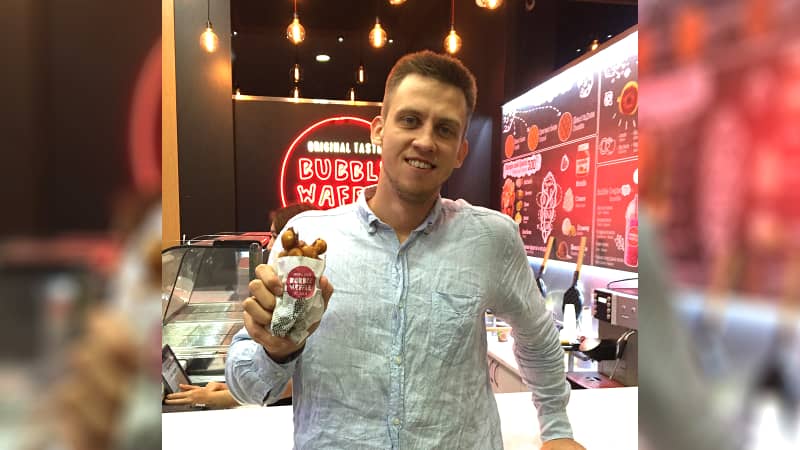
Oleg Sabsai claims to be the first person to transform the traditional egg waffle into an ice cream dessert.
Oleg Sabsai
“I’m the real founder of Bubble Waffle Network,” Sabsai confirms.
After establishing a business selling bubble tea in 2009, the Ukrainian says he began searching for the next business idea that “could be import-independent, made with natural ingredients, cooked in an open kitchen and was appealing to the customers.”
He stumbled upon Hong Kong egg waffles and opened the first Bubble Waffle Network shop in Ukraine. (Not to be confused with the imposter bubble waffle I tried in London).
“You will be surprised, but I never tasted these waffles — I found a video on YouTube with an authentic street vendor baking gai daan jai on charcoal heat. In 2013, there wasn’t much content about it online,” says Sabsai.
With an investment of $300, used to buy two electric waffle makers online — “one of the machines was broken,” adds Sabsai — and experimenting with many recipes at home, he started selling bubble waffles in a shopping mall.
“At the end of the first sales day in the most crowded location, we had zero sales and our spirit was shattered,” he tells me.
“Customers were not interested in our product as a native Hong Kong business model. But there was no way back. Our first franchisee partners already ordered furniture and equipment in Russia and Kazakhstan. Finally, the inspiration came: I turned a bubble waffle into a cone, put fillings inside the bubbles and ice cream/whipped cream in the cone.”
That was a golden, game-changing idea, he recalls.
“The photos of the new product made a huge boom in the history of bubble waffles. Suddenly this new look became one of the most attractive foods in the world,” says Sabsai.
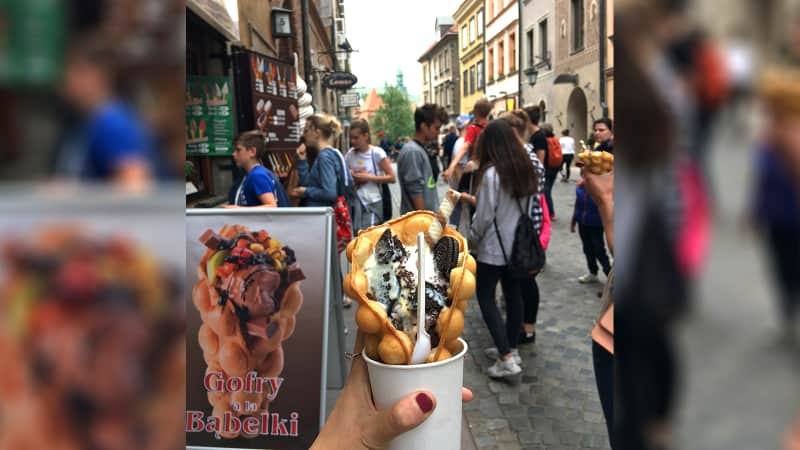
The evolved bubble waffle, served as an ice cream cone, has helped the Hong Kong creation gain popularity in Europe. This version was found in Warsaw, Poland.
Maggie Wong
But with demand on the rise, he faced more challenges from franchisees complaining about the imported equipment.
“These Chinese waffle makers couldn’t work sustainably with such high customer traffic so we have lost the franchise network,” says Sabsai.
In response, the Ukrainian businessman has been spending the last three years developing his own Teflon-free, durable electronic waffle irons.
“It is my dream to come to Hong Kong and finally taste the egg waffle from the authentic street vendors,” he says.
“I am sure there is a reason why it’s so beloved by the people. I am grateful to them for coming up with the idea of this food in the ’50s.”
Sabsai’s reinvented bubble waffles appear to have caught on, with imitators now popping up all around the world.
My failed Hong Kong egg waffle business
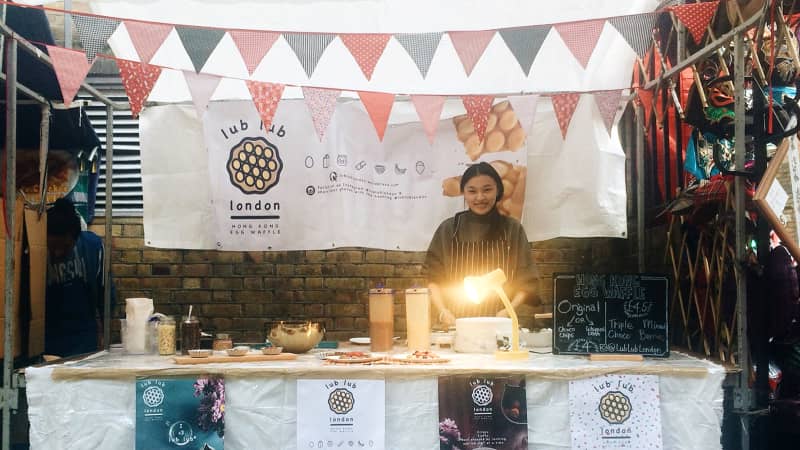
I didn’t make a profit selling egg waffles but they helped me connect with people from around the world, deepening my affection for my own city.
Maggie Wong
My version of bubble waffles was a lot simpler. I offered three flavored bubble waffle bases — plain, chocolate and matcha. Waffles were topped with whipped cream, fresh fruits and chocolate.
I didn’t make a profit selling them but, unexpectedly, they helped me connect with people from around the world, deepening my affection for my own city along the way.
I — along with my toes — am forever grateful to the Turkish couple who ran the stall next to me at London’s Brick Lane Market and made me sit in front of their heater on chilly days and appreciated my bubble waffles.
And then there was a kid, the son of fellow vendors, who would sneak into my booth and signal to me to smuggle him a chocolate waffle.
I will also always remember the skeptical fellow Hong Kongers living in London — “Is this the real thing?” they would ask — who later came back as trusting customers looking to enjoy a piece of home.
There were also customers who asked me about Hong Kong, or came to share their fond memories of visiting my city.
Before I left London and returned to Hong Kong in 2017, I was invited to a local Chinese association’s community center.
“Today, we will buy gai daan jai from Maggie so she has money to fly back to Hong Kong,” a volunteer announced half-jokingly to other members.
The Hong Kong aunties and uncles, who had moved to the UK decades ago, enthusiastically bought my egg waffles during breaks between their table tennis sessions, asking me what was new in Hong Kong these days.
Professor Cheung, I feel, sums up both my experiences and the global rise of gai daan jai best.
“The new styles of bubble waffles may have detached from their original form but have kept their original meaning and symbol, which is the flavor of Hong Kong.”
